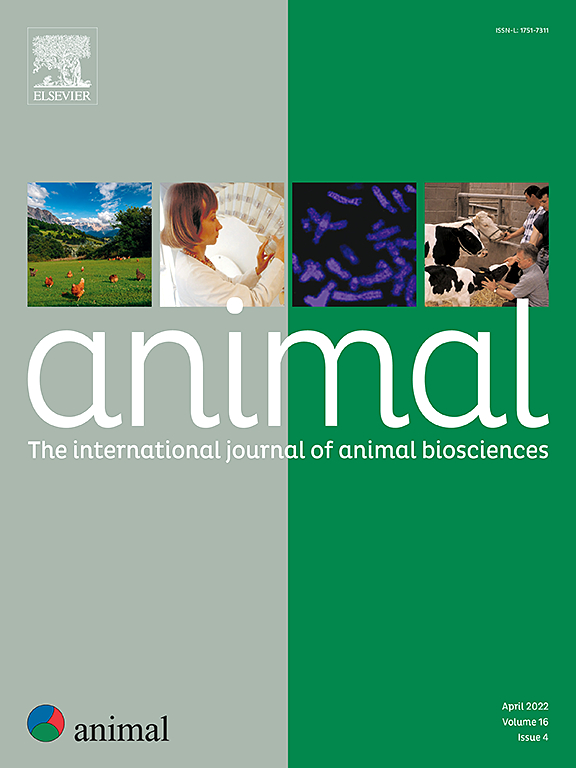荷斯泰因-弗里舍奶牛春季产犊年龄、初产体重与生产力关系的横断面分析
IF 4.2
2区 农林科学
Q1 AGRICULTURE, DAIRY & ANIMAL SCIENCE
引用次数: 0
摘要
初产犊龄(AFC)是决定小母牛饲养成本的关键因素之一。虽然为了尽量减少非生产期,建议使用年轻的AFC,但在以前,年轻的产犊与产奶量减少有关。然而,首次产犊时较重的体重可能会抵消与首次产犊时较年轻相关的次优性能。本研究的目的是利用在爱尔兰8个研究农场收集的数据,在15年的时间里,量化放牧的季节性产荷斯泰因-弗里泽奶牛的年龄和初产犊时的体重(在产犊后5至20天测量)以及此后的生产性能之间的关联。共收集1 ~ 3胎次1头奶牛2 924份产犊、泌乳、繁殖性能、体重和体况评分(BCS)记录进行分析。初产体重、AFC和胎次之间的交互作用仅存在于泌乳期前60天的平均乳蛋白百分比,而初产体重和AFC之间的双向交互作用与所考虑的任何其他性能变量无关。首次产犊年龄与产犊性能或所调查的任何体重和体重特征无关。虽然AFC与随后的产奶量无关,但它与最年轻和最年长的初产母牛第一次泌乳时乳脂和蛋白质百分比的降低有关。在随后的胎次中,初产犊的年龄较大的小母牛的初产犊至首次服务间隔较短。初产犊体重与产犊性能无关。在假定AFC恒定的情况下,初产犊时较重的体重与前三次泌乳的产奶量、60天和305天乳脂率以及305天乳蛋白率相关。虽然初产体重对繁殖效率没有长期影响,但初产体重较重的母牛需要较少的服务才能怀孕,并且从产犊到首次服务的间隔时间较长。第一次产犊时较重的小母牛在第一胎、第二胎和第三胎中也较重,条件也较好。尽管如此,本研究的结果仅限于研究群体初产犊时的AFC和体重范围。生产性能最好的时期是平均AFC为738 ~ 768日龄,初产体重为516 ~ 550公斤。本文章由计算机程序翻译,如有差异,请以英文原文为准。
Cross-sectional analysis of the associations between age and body weight at first calving and productivity in spring-calving Holstein-Friesian dairy cows
Age at first calving (AFC) is one of the key determinants of heifer rearing costs. Although a young AFC is recommended in order to minimise the non-productive period, calving at a young age has previously been associated with a reduction in milk production. Heavier BW at first calving may, however, negate the suboptimal performance associated with such a younger age at first calving. The objective of this study was to quantify the associations, using data collected on eight Irish research farms over a 15-year period, between both age and BW at first calving (as measured between 5 and 20 days postcalving) and performance thereafter in pasture-based seasonal-calving Holstein-Friesian dairy cows. A total of 2 924 calving, lactation, reproductive performance, BW and body condition score (BCS) records from 1 323 parity one to three cows were available for analysis. An interaction between BW at first calving, AFC, and parity only existed for mean milk protein percentage in the first 60 days of lactation, while a 2-way interaction between BW at first calving and AFC was not associated with any of the other performance variables considered. Age at first calving was not associated with either calving performance or any of the BW and BCS traits investigated. Although AFC was not associated with subsequent milk yield, it was associated with reduced milk fat and protein percentage in the first lactation for the youngest and oldest first−calving heifers. Older heifers at first calving had a shorter calving to first service interval in subsequent parities. BW at first calving was not associated with calving performance. A heavier BW at first calving, assuming a constant AFC, was associated with greater milk yield, 60 and 305-day milk fat percentage, and 305-day milk protein percentage in each of the first three lactations. Heavier heifers at first calving required fewer services to conceive, and had longer intervals from calving to first service, although there was no long-term influence of BW at first calving on reproductive efficiency. Heavier heifers at first calving were also heavier and more conditioned throughout the first, second, and third parities. Results from the present study are nonetheless confined to the ranges in AFC and BW at first calving in the study population. Performance was best when heifers had a median AFC between 738 and 768 days and a BW at first calving between 516 and 550 kg.
求助全文
通过发布文献求助,成功后即可免费获取论文全文。
去求助
来源期刊

Animal
农林科学-奶制品与动物科学
CiteScore
7.50
自引率
2.80%
发文量
246
审稿时长
3 months
期刊介绍:
Editorial board
animal attracts the best research in animal biology and animal systems from across the spectrum of the agricultural, biomedical, and environmental sciences. It is the central element in an exciting collaboration between the British Society of Animal Science (BSAS), Institut National de la Recherche Agronomique (INRA) and the European Federation of Animal Science (EAAP) and represents a merging of three scientific journals: Animal Science; Animal Research; Reproduction, Nutrition, Development. animal publishes original cutting-edge research, ''hot'' topics and horizon-scanning reviews on animal-related aspects of the life sciences at the molecular, cellular, organ, whole animal and production system levels. The main subject areas include: breeding and genetics; nutrition; physiology and functional biology of systems; behaviour, health and welfare; farming systems, environmental impact and climate change; product quality, human health and well-being. Animal models and papers dealing with the integration of research between these topics and their impact on the environment and people are particularly welcome.
 求助内容:
求助内容: 应助结果提醒方式:
应助结果提醒方式:


